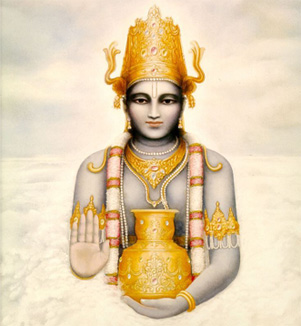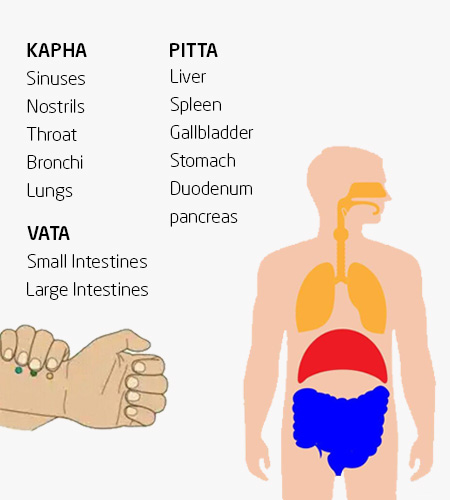About Ayurveda
Ayurveda is the traditional medicine of ancient India and the oldest system of healthcare originated more than 5000 years ago.
A system that can be used for both preventative and curative medicine,
Fundamental to Ayurveda is the understanding that each person is unique and as a result,each person's path toward optimal health is unique.
Ayurveda helps one to recognise what types of foods, weather, lifestyle and other stimuli will create a state of balance and harmony in their unique body, mind and soul.
When the body and mind are in harmony, normal physiology is restored and healing takes place.

Dosha - Ayurveda defines physiology in terms of three forces called doshas. The three doshas are vata, pitta and kapha. Vata governs the physiology of motion in the body. Pitta governs the physiology of metabolism. Kapha governs the physiology of structure. Each person has all three of these doshas within them.
Prakriti- The balance of these three doshas at the moment of conception defines what Ayurveda calls one's constitution, or "prakruti". These doshas also fluctuate in accordance with how we live our lives and as they increase or decrease they cause different conditions in the body and mind.
Vikruti- IMBALANCED IN THESE DOSHAS CREATE VIKRUTI".
The goal of Ayurveda is to restore the proper balance of these physiological forces. This is accomplished by utilizing one's senses properly and living a healthy lifestyle.
Ayurvedic definition of optimum health
सम दोष समाग्निश्च सम धातु मल क्रियाः | प्रसन्न आत्मेन्द्रिय मन स्वस्थ इत्यभिधीयते ||
(Sushruta )
Sama Dosha Sama Agnis Cha Sama Dhatu Malakriya
Prasnna Atma Indiriya Manaha Swastha Iti Abhidheeyate-
One Is In Perfect Health When These Three Doshas ( Vata, Pitta And Kapha), Digestive Fire, All The Body Tissues And Componenets Are In Perfect Order With A Pleasantly Disposed, Contented Mind, Senses And Spirit
The philosophy of Ayurveda
According to a Hindu philosophy, the evolution of a human being becomes possible after he/she has lived through 840,000 previous births. This symbolic figure is meant to emphasize the uniqueness of our humanity. It implies that the human race is special and that our goal is to rediscover and cherish our existence upon this earth. Ayurveda accepts this symbolism. It also emphasizes the connection between humans and other worlds, making our race a part of the larger universe. Ayurveda subscribes to these values of cherishing life and discovery of meaning in our existence.
Another goal in Ayurveda is to achieve Nirvana or liberation from all kinds of "wants". This is primarily achieved through good health, which is regarded as the supreme foundation of life. A healthy and happy person is no burden to anyone and with the right attitude can contribute to the welfare of others as well as his own. This state of being is called Virtue in Sanskrit meaning leading a virtuous life. Its opposite is Kamma or temptation, which is accompanied by irregular living and disease. With this view, Ayurveda cultivates the awareness that balanced living leads us to being virtuous or to Nirvana and freedom from all "wants".
Balance in Ayurveda
In clinical terms, Ayurveda advocates that our health is regulated by three fundamental values, called vata, pitta, and kapha. Vata governs movement, Pitta is concerned with functions of heat, metabolism, and energy production and Kapha, governs physicalstructure and fluid balance. As a group they are known as the quality of "dosha", or imperfections. These three factors govern all the activities of our mind and body and they have to be balanced through intelligent choices for optimal health. The main purpose of Ayurvedic treatments is to establish the balance in these three fundamental qualities.The sub branches of Ayurvedic medical knowledge.
What you need for a balance
Your health can be simplified to three fundamental principles of nature called Vata, Pitta, and Kapha [these three are called Dosha]. These three factors govern all the activities of your mind and body. When they are in balance , health is optimal. The main purpose of all Ayurvedic treatments is to establish balance in these three fundamental principles.

Ayurveda has eight specialized branches as follows
- Kaya chikitsa or Internal medicine
- Salya tantra or Surgery
- Salakya tantra or Management of diseases of Eye & ENT
- kaumar bhutya or Pediatrics
- Bhutavidya or Psycho-therapy including Seizures by evil spirits
- Agada tantra or Toxicology
- Rasayana tantra or Geriatrics
- Vajikarana tantra or the Science of aphrodisiacs
Ayurveda includes the Astronomical science, Astrology including Indian philosophy. Health is the supreme foundation of Virtue, Wealth, Kamma and diseases are the destroyers of Life and Shreyas. According to Hinduism after eighty four lacs of births, a human being is evolved; hence human form is the only stage when man can liberate himself from this cycle of births and deaths. Thus, man's life is the most significant and precious in which he has to strive hard for Liberation-Nirvana.
With this view in mind Ayurveda denotes that this body, the media to Nirvana is to be cared for, just as a Mayor takes care of the city and charioteer daily oils his axle and keeps clean, similarly one has to take care of his body. Ayurveda prescribes "dos and don'ts" for the preservation as well as promotion of positive health and prevention as well as cure of diseases.
- Basic Functions:
- Vata: Governs bodily functions concerned with movement.
- Pitta: Governs bodily functions concerned with heat, metabolism, and energy production
- Kapha: Governs bodily functions concerned with physical structure , and fluid balance
- Qualities : ( Which is Your Dosha ? Diagnose Yourself )
- Vata: Moving quick, light, cold, minutes, rough dry, leads the order Doshas.
- Pitta: hot, sharp, light, acidic, slightly, oily.
- Kapha: heavy, oily, slow, cold, steady, solid, dull.
- Results of Balance Vata :
- Mental alertness.
- Proper formation of body tissuesn
- Normal alimentation.
- Strong immunity
- Sound sleep
- Sense of exhilaration
- Results of Balance Pita :
- Normal heat and thirst mechanism
- Strong digestion
- Sharp intellect
- Lustrous complexion
- Contentment
- Results of Balance Kapha :
- Results of balance Kapha
- Strong immunity
- Affection, generosity, courage, dignity
- Healthy ,Normal, Joints
- Vitality and stamina
- Stability of mind
RESULTS OF IMBALANCE
- Imbalanced Vata
- Dry or Rough Skin
- Constipation
- Common fatigue ( non-specific cause )
- Tension headaches
- Underweight
- Insomnia
- Intolerance of cold
- Anxiety, worry
- Imbalanced Pita :
- Rashes, skin inflammations
- Heartburn
- Premature graying, baldness
- Hostility, irritability
- Visual problems
- Excessive body heat
- Imbalanced Kapha :
- Oily skin
- Sinus congestion
- Obesity
- Slow digestion
- Nasal allergies
- Lethargy, dullness
- The six tastes and examples :
- Sweet: Sugar, milk, butter, rice, breads, Pasta
- Sour: Yogurt, lemon, cheese
- Salty: Salt
- Pungent: Spicy foods, ginger, hot peppers,Cumin
- Bitter: Green leafy vegetables, Turmeric
- Astringent: Beans, Lentils, Pomegranate
- How to use the six tastes :
- To Decrease Vata- Sweet, Sour, Salty
- To Increase Vata- Pungent, Bitter, Astringent
- To Decrease Pitta- Sweet, Bitter, Astringent
- To Increase Pitta- Pungent, Sour, Salty
- To Decrease Kapha- Pungent, Bitter, Astringent
- To Increase Kapha- Sweet, Sour, Salty
The Sharma Clinic Was Founded More Than 100 Years Back...
Started Ayurvedic Clinic in 1916 at Ahmedabad - INDIA.
